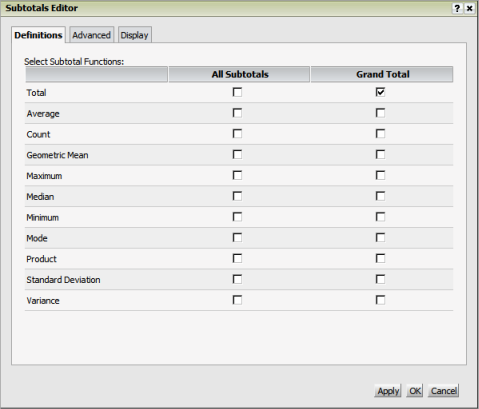
The Edit Totals dialog allows you to enable totalling metrics on the report as well as define the placement of the totals and the breakpoints for those totals. This dialog has three tabs as follows:
· Definitions - to define the type of totals to be displayed in the output
· Advanced - to define the axis or attribute used to generate the totals
· Display - to define the placement of the totals on the report
This tab allows you to enable/disable the different types of subtotal functions for the report. the most commonly used function would be the "Total" option. All of these totalling functions may be defined based on breakpoints within the report or the overall report only:
· All Subtotals - applies the totalling function to each combination of values for the attributes included on the report (e.g., if you had Servicer and Data Type as your attributes, you would see a sub-total for each combination of Servicer and Data Type values).
When the All Subtotals function is checked, the corresponding Grand Total function is checked and disabled as you must provide Grand Totals if you are including subtotals.
· Grand Total - applies the totalling function to the overall report. These options will not enable any subtotals for the report output. You must define those by checking the function on the All Subtotals column.
The following sample of the Definitions tab displays the totalling functions available for selection. As noted above, the most commonly used is the "Total" function; but you may also apply minimum, maximum, mean, average, etc as needed. Depending on the metric, some functions may not be available for selection and the checkbox will be disabled.

This tab allows you to specify the level and axis used for the totalling. You may specify for a metric subtotal to be calculated by position on the report rows, columns, and page-by fields, or across specific levels on the report. You can also specify the level at which you want the subtotal to be calculated.
When you select the Across Level option, the attributes you have on the report will be included in the selection list. You may check any that you wish to use for totalling. Each combination of values for the selected attributes will be used to subtotal the report metrics (e.g., if you selected Issuer and Data Type, the report will provide a subtotal for each combination of Issuer and Data Type values).
The drop down specifies the type of total being defined (e.g., Total, Average, et al) and they you specify how the totals are to be calculated and the basis for the totals (e.g., total each column, total each row, total each page or total across levels of attributes). The most commonly selected total option is Across Levels and then you specify the combination of the attributes for totalling.

This tab allows you to specify the placement of the totals within the report layout. The settings will be applied based on the settings in the Advanced tab. When totalling by row, you specify if you wish to display the totals at the top or bottom of the breakpoint. When totalling by column, you specify if you wish to display the totals to the right or left of the breakpoint. When totalling by page, you specify if you wish to display at the top of bottom of each page.
When applying totals Across Levels, the totals are usually calculated by row; for this option, you would define the placement by Rows. This is not always the case, you may have attributes in column headers and the totals may be applied by columns.
